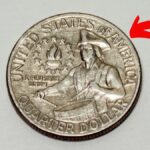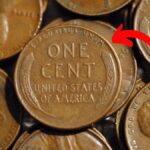The Lincoln Wheat Penny is a classic American coin that has captured the interest of collectors for decades. Originally minted from 1909 to 1958, these pennies are still in circulation today, but certain rare versions of this coin can fetch astonishing prices, even reaching as high as $950,000. This article will delve into the history, value, and significance of the Lincoln Wheat Penny, highlighting why certain specimens are worth such incredible amounts of money.
The History of the Lincoln Wheat Penny
The Lincoln Wheat Penny was first introduced in 1909 to commemorate the 100th anniversary of Abraham Lincoln’s birth. The coin features the portrait of President Lincoln on the obverse (front) and two wheat stalks on the reverse (back). This design was created by sculptor Victor David Brenner and was used until 1958, when it was replaced by the Lincoln Memorial design.
The Wheat Penny became a staple of American currency, and it remained in circulation for nearly 50 years. During its time in production, over 30 billion of these pennies were minted. While most of these pennies are relatively common and only worth their face value of one cent, some rare varieties are highly sought after by coin collectors and can command large sums at auctions.
The Value of the Lincoln Wheat Penny
The value of a Lincoln Wheat Penny can vary greatly depending on several factors, such as its year of minting, condition, and rarity. Most Lincoln Wheat Pennies are worth only a few cents or dollars, especially if they are worn or damaged. However, there are specific rare versions of the coin that have become incredibly valuable.
One such penny, the 1943 copper Lincoln Wheat Penny, is valued at around $950,000. This rare coin was mistakenly minted in copper instead of the usual steel during World War II when copper was in short supply. Only a few of these copper pennies were produced, making them highly valuable to collectors. The 1943 copper penny is one of the most famous examples of a Lincoln Wheat Penny fetching such a high price.
Another example is the 1909-S VDB Lincoln Wheat Penny, which is worth thousands of dollars depending on its condition. The “VDB” refers to the initials of the designer, Victor David Brenner, which were briefly placed on the reverse of the coin before being removed due to public outcry. The 1909-S VDB is rare because of its low mintage, making it a prized possession for coin enthusiasts.
Why Are Some Lincoln Wheat Pennies Worth So Much?
The main reasons that certain Lincoln Wheat Pennies are worth such high amounts come down to rarity, error, and demand. The 1943 copper penny, for example, is valuable because of the mistake that occurred during its minting. Due to a mix-up at the U.S. Mint, a few copper planchets (the metal discs used to strike coins) were used instead of the steel planchets that were supposed to be used for pennies during that year. These rare copper pennies are now worth hundreds of thousands of dollars due to their limited supply and the mistake that caused their creation.
The 1909-S VDB penny is valuable because of its low mintage and the controversy surrounding the designer’s initials. When the “VDB” initials were added to the reverse of the coin, there was public outcry, and the Mint removed the initials shortly after. This low mintage, combined with the fact that only a small number of the 1909-S VDB coins were produced, makes it a highly coveted coin among collectors.
The overall condition of the coin also plays a significant role in its value. Coins that are in pristine, uncirculated condition are worth far more than those that are heavily worn or damaged. Coins are graded based on their appearance, and those with high grades can command much higher prices in the marketplace.
Collecting Lincoln Wheat Pennies
For coin collectors, Lincoln Wheat Pennies are a popular and accessible entry point into the world of numismatics (the study and collection of coins). Since these pennies were produced in large numbers over many decades, collectors can often find them in circulation or in coin rolls at relatively low prices. However, rare versions of the coin, such as the 1943 copper penny or the 1909-S VDB penny, are much harder to come by.
Many collectors focus on completing a full set of Lincoln Wheat Pennies, which includes coins from each year of minting and each mint mark. There are also various special editions, such as proof coins, which were made for collectors and have a higher quality strike than regular circulation coins.
The hunt for rare coins, including the Lincoln Wheat Penny, can be an exciting and rewarding experience for collectors. Some collectors even search through change and coin rolls, hoping to find valuable coins among the more common ones. While it’s unlikely that every coin collector will stumble upon a $950,000 penny, finding a rare and valuable Lincoln Wheat Penny can still be a thrilling discovery.
Where to Find Lincoln Wheat Pennies
Despite being a part of the past, Lincoln Wheat Pennies are still in circulation today, though they are becoming less common as time passes. Many people have old jars or coin collections that include these pennies, and they can sometimes be found in circulation when checking loose change or coin rolls. For those looking to find specific rare versions of the coin, such as the 1943 copper penny, it is best to check reputable coin dealers, auction houses, and online marketplaces.
Coin collectors often attend coin shows and conventions where they can buy, sell, and trade Lincoln Wheat Pennies and other rare coins. These events provide a great opportunity to find valuable coins, meet other collectors, and learn more about the history of coinage.
Conclusion
The Lincoln Wheat Penny, originally minted over a century ago, is still a valuable and iconic piece of American history. While most of these coins are worth only their face value of one cent, rare versions of the penny, such as the 1943 copper penny and the 1909-S VDB penny, can fetch extraordinary prices, with some reaching as much as $950,000. These rare pennies are highly prized by collectors due to their rarity, historical significance, and the mistakes that occurred during their minting. Whether you’re a seasoned coin collector or a beginner, the Lincoln Wheat Penny offers a fascinating glimpse into the world of numismatics and the potential for discovering rare and valuable coins.
Disclaimer: The information provided in this article is for educational purposes only and may not reflect the most current market values. Always consult a professional numismatist or trusted source for up-to-date coin valuations.





